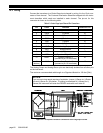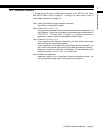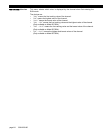
SC Series Instruction Manual page 67
Strain-Gage Input Channel10
10.5.4
CALIBRATION TYPE
Menu Item
This chooses the type of calibration technique to be used. There are three meth-
ods that can be used to calibrate the transducer to the Input Channel. Each has
advantages and disadvantages as described in the table below.
It is important to know your application in order to select the appropriate cali-
bration type. mV/V (“millivolt-per-volt”) Calibration is recommended for most
applications because it doesn’t require known loads and it allows easy swapping
of transducers equipped with Signature Calibration. When the best possible
accuracy is required, Known-Load Calibration is recommended.
The choices for this menu item are:
•“
TYPE= SHUNT CAL
” means Shunt Calibration. First, you are prompted to apply
the load entered in the “
ZERO SCALE VALUE
” register. Next, the instrument inserts
Table 4-4: Comparison of Calibration Types
Shunt
Calibration
mV/V
Calibration
2-, 3-, or 5-
point
Known Load
Calibration
RECOMMENDED...
...for most applications no yes no
...when frequently swapping
transducers
yes yes no
...when best possible accuracy
required
no no yes
PROS and CONS
Relative accuracy good better best
Requires actual, calibrated loads
to be applied
no no yes
Automatically calibrates with Sig-
nature Calibration transducers
yes yes no
Max. distance of transducer from
instrument w/out sense wires
15’ [5m] 50’ [15m] 300’ [100m]
Max. distance of transducer from
instrument with sense wires
15’ [5m] 100’ [30m] 300’ [100m]
CALIBRATION TECHNIQUE
Zero-scale point from... applied load applied load applied load
Full-scale point from... transducer
output when
shunt resistor
applied
internal refer-
ence
applied load
Linearity correction from... data stored in
Signature
Module (if
available)
data stored in
Signature
Module (if
available)
2-point: none
3- or 5-point:
applied load


















